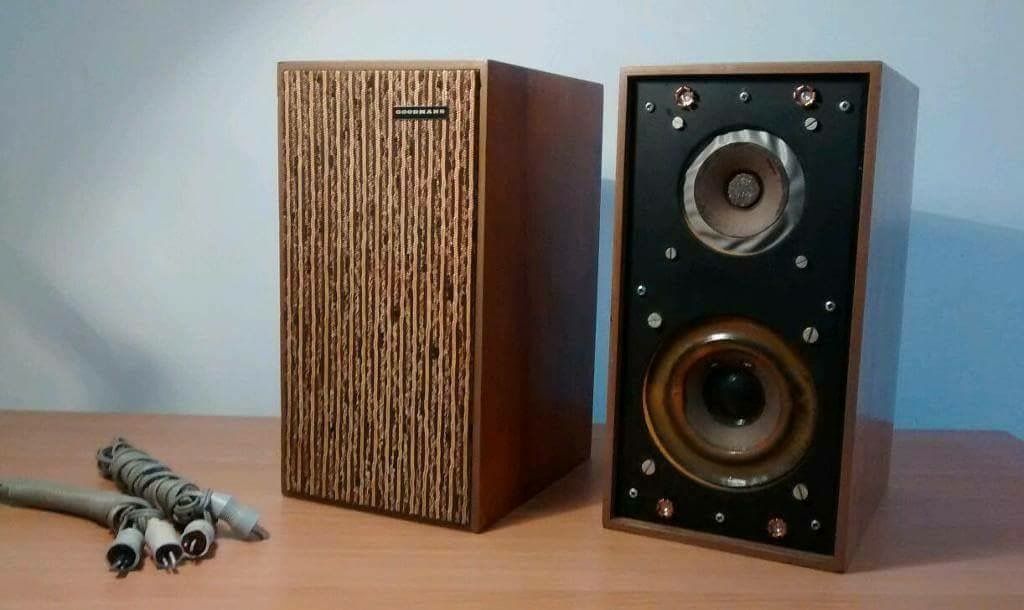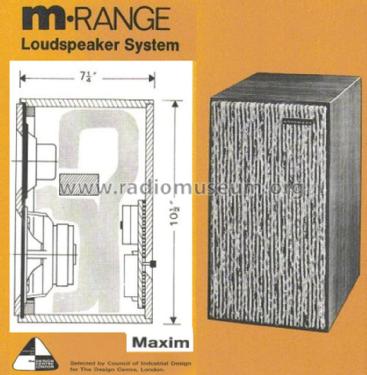You are using an out of date browser. It may not display this or other websites correctly.
You should upgrade or use an alternative browser.
You should upgrade or use an alternative browser.
Voicing of the original Goodmans Maxim mini-monitor
- Thread starter ToTo Man
- Start date
Craig B
Re:trophile
According to Joe Akroyd's Wikipedia page, he had a hand in designing the Maxim, the popular Audiom and Axiom drivers, as well as a number of early '70s Wharfedale models...Wasn't they designed by Joe Akroyd?
"Prior to starting Royd Audio, Joe Akroyd worked for Goodmans in the early 1960s, where he contributed to the Maxim mini monitor and the Audiom and Axiom bass drivers. In 1970, Joe Akroyd joined Wharfedale, where he was involved in the manufacture and design of the Denton, Linton, Melton, Triton, Doredale loudspeakers. During the mid-1970s Joe Akroyd joined Decca, in their newly reorganized Speaker department.[2] However in 1979, Racal bought Decca,[3] at which point Joe Akroyd left to set up Royd Audio." Wikipedia
Martyn Miles
pfm Member
Often speakers have more than one person’s design input.
The LS3/5a had input from Technicial staff as well as Senior staff, but they weren’t always given credit.
I designed apparatus at Oxford University’s Chemistry Laboratory, but wasn’t given credit for it.
It was often mentioned on the annual report and that was all.
The LS3/5a had input from Technicial staff as well as Senior staff, but they weren’t always given credit.
I designed apparatus at Oxford University’s Chemistry Laboratory, but wasn’t given credit for it.
It was often mentioned on the annual report and that was all.
Craig B
Re:trophile
The Akroyd Decca Loudspeaker Department connection is interesting, as the top model in the initial 'Akroyd' loudspeaker model line-up was The Ribbon 40, a resistive reflex box with a Decca London Ribbon.
Akroyd Brochure, side 1
Akroyd Brochure, side 2
Akroyd Brochure, side 1
Akroyd Brochure, side 2
davidmeols
New Member
I have Goodmans 2 Maxims. The first bought in early 1960's, (I would have thought 1963 but a comment above suggest it was not available until 1965) the second about 4 years later. The earlier one has a GOODMANS label on the front, teminal connections and 'Goodmans Industries' as the manufacturer on the back. The later one has a G Logo on the front, socket connection and 'Goodmans Loudspeakers Ltd' as the manufacturer.
I have always known that the earlier one is less sensitive than the later one, but when balanced with the amp they sound the same to my ears.
Now I come to try to sell them and check the weight for postage purposes I find that the older one weighs 3.9 kilos, the newer, 2.9 kilos, an huge difference.
Has anyone a plausible explanation for this? Alnico springs to mind, but surely suitable Alnico speakers would have been available by 1963 and a difference of a kilo in the weight of the speakers sounds improbable.
It would also be interesting to know which model was being used by the BBC for their comparisons.
I have always known that the earlier one is less sensitive than the later one, but when balanced with the amp they sound the same to my ears.
Now I come to try to sell them and check the weight for postage purposes I find that the older one weighs 3.9 kilos, the newer, 2.9 kilos, an huge difference.
Has anyone a plausible explanation for this? Alnico springs to mind, but surely suitable Alnico speakers would have been available by 1963 and a difference of a kilo in the weight of the speakers sounds improbable.
It would also be interesting to know which model was being used by the BBC for their comparisons.
Martyn Miles
pfm Member
When I was at Falcon Acoustics some years ago, I noticed a pair of Maxims on Jerry Bloomfield’s shelf of
small speakers, next to some prototype LS3/5as.
I mentioned I’d bought a pair for someone back in the late ‘60s and asked Jerry what he thought of them.
All he said was ‘interesting.’
I decided to leave it at that...
small speakers, next to some prototype LS3/5as.
I mentioned I’d bought a pair for someone back in the late ‘60s and asked Jerry what he thought of them.
All he said was ‘interesting.’
I decided to leave it at that...
Darmok
pfm Member
What intrigues me is that these Goodman's mini monitors use metal as the baffle material. I recently acquired some Radford monitors (not mini at all) which are a three way design using Goddman's drivers. The baffle for the two smaller units, which is in a separated section of the cabinet, also use metal as a baffle material and I had not come across that before. Was this quite common back in the 60's or was it a technique favoured by some manufactures/designers?
Radford Electronics used the same Goodmans Maxim Mid / Bass drive unit in their first 3 way monitor loudspeakers and their first Transmission Line loudspeaker.
I have a pair of original Maxims boxed like new bought for the princely sum of 3 squid at a boot sale.
One broken tweeter inside, the magnet broken away from the chassis.
The maxamp was a turd of a thing, after i gave up trying to build a sinclair 2000 i ended up with a maxamp.
It had those short lived early transistors in it...are they Germanium?
and it had trembler fuses which were forever blowing into my
Wharfdale Dovedales ( rank era ) I still have some trembler fuses and even sent some off to a fishy maxamp owner ages back.
When working it had a valvey sound to it which mayhave been intentionally as the maxamp was a first generation big seller for transisitors.
Unless Im confusing the Sony ST Range tuner here ...?
There was a matching tuner was and remains the next design jewel after the speakers which were too expensive for The student I was
It had those short lived early transistors in it...are they Germanium?
and it had trembler fuses which were forever blowing into my
Wharfdale Dovedales ( rank era ) I still have some trembler fuses and even sent some off to a fishy maxamp owner ages back.
When working it had a valvey sound to it which mayhave been intentionally as the maxamp was a first generation big seller for transisitors.
Unless Im confusing the Sony ST Range tuner here ...?
There was a matching tuner was and remains the next design jewel after the speakers which were too expensive for The student I was
Last edited:
pil
pfm Member
Bit of thread gravedigging. I have a pair of the Videoton Minimax
I know they were made in hungry,but they have a very similar look to the Goldman’s
From what I can make out,the Goldman’s were released before the Videoton. Has anyone heard both pairs?
I use mine with one those all in one denon things. They sound very good,especially on speech
I know they were made in hungry,but they have a very similar look to the Goldman’s
From what I can make out,the Goldman’s were released before the Videoton. Has anyone heard both pairs?
I use mine with one those all in one denon things. They sound very good,especially on speech
Martyn Miles
pfm Member
I acquired a pair of Maxims at trade price, in ‘69 I think it was.
My father had an account with a wholesaler.
Fitted to a long mantelpiece in a friend’s house ( with built-in connectors in the wall ) they sounded quite good.
There were there for decades.
As for Videoton Minimaxes, a friend bought a pair in the early ‘70s.
I really didn’t rate them.
My father had an account with a wholesaler.
Fitted to a long mantelpiece in a friend’s house ( with built-in connectors in the wall ) they sounded quite good.
There were there for decades.
As for Videoton Minimaxes, a friend bought a pair in the early ‘70s.
I really didn’t rate them.
Last edited:
Bob McC
Living the life of Riley
Google warning that link does not have a valid certificate.If you're referring to the Maxim, it was designed by Ted Jordan:
https://www.avhub.com.au/features/hi-fi/obituary-e-j-8216ted8217-jordan-440846
Darmok
pfm Member
I dunno whether I should share with you Fishes, "Arthur Hedley Radfords" personal opinion of Harold J Leak and Peter Walker as his closest commercial rivals.Not a very nice character was Mr. H Leak...
calorgas
Generic middle-aged man
Of course you should, we need to know!I dunno whether I should share with you Fishes, "Arthur Hedley Radfords" personal opinion of Harold J Leak and Peter Walker as his closest commercial rivals.
Locheeboy
pfm Member
You are correct.
The Tobey-Dinsdale design Harold Leak stole was used by Truvox as well a Goodmans.
Not a very nice character was Mr. H Leak...
The Teifenbraun of the 50s and 60s…..
Darmok
pfm Member
Do you ALL really want to know?Of course you should, we need to know!
I would need a green light from the Administrator who owns this forum (his living) to share with you this personal opinion as the answer would / could be very upsetting for many Leak and Quad owners / users here and on-line elsewhere imv.
Just think first, why is it that Radford valve amps are / were in a different league than all of the competition at that time.
Last edited:
calorgas
Generic middle-aged man
Well I can't speak for anyone else especially Mr L, but I'd have thought that this is all sufficiently in the past for one designer/manufacturer's view of the others to be aired, as sales numbers and many years of owners opinions can also be taken into account. I've owned vintage Leak and Quad but never a Radford yet so just interested as it sounds like it could be controversial 
Darmok
pfm Member
Arthur H Radford was a hi-fi designer and polymath, he evaluated his competitive productsWell I can't speak for anyone else especially Mr L, but I'd have thought that this is all sufficiently in the past for one designer/manufacturer's view of the others to be aired, as sales numbers and many years of owners opinions can also be taken into account. I've owned vintage Leak and Quad but never a Radford yet so just interested as it sounds like it could be controversial
in his laboratory and discovered their shortcomings.
These shortcomings have been displayed here with several very interesting restorations re Leak and Quad valve amplifiers and their deficiencies were eliminated.
Arthur made a very disparaging comment to his design team way back in the 60's whilst he was evaluating these foresaid products.
Until TL gives me a green light, this is as far as I can share here on pfm.


